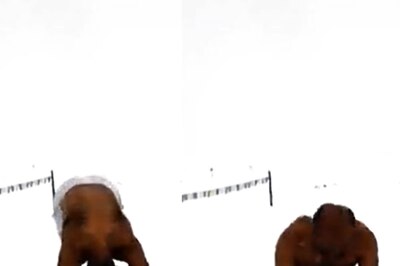
views
Tel Aviv University researchers have found a technique which could help people to talk to animals.
Dr Yossi Yovel and his team from Tel Aviv University in Israel employed ultrasonic frequency detectors to “translate” bats’ communicating calls and it is believed that this technology could go further.
Dr Yovel, while explaining the finding, which he called a “miracle”, reportedly said that bats generate mixed-frequency vibrations that reverberate around them. According to him, bats’ brains may pick up these echoes and use them to conjure up a mental image similar to “zooming in and out with your eyes” and this is related to their animal “language,” but not expressly so.
He talked about echolocation, which is a physiological process that uses sound waves reflected back to the emitter (such as a bat) to locate distant or invisible objects (such as prey).
As reported, the researcher said: “Echolocation, even though its prime function is sensing, it can definitely be used to convey social information. There’s a lot of literature on bats eavesdropping, listening to what the other bats are saying.”
However, according to Dr Yovel, animal communication could be revolutionised thanks to machine learning.
“We recorded several bats over months… annotating the context in which these vocalisations were emitted. We showed that we can determine the context of the vocalisation based on its spectral parameters. So we can say this vocalisation was emitted during fighting over food for example, with very high accuracy,” he explained.
The group discovered that they could also identify who was speaking, such as whether it was a male arguing over food. The researcher stated that none of it would be possible without the assistance of technology.
Dr Yovel said: “The truth is that it’s very difficult to hear differences between them. But once you use these machine learning algorithms, we manage to find differences between them.”
Other Studies
Natalie Uomini, a cognitive scientist studying the New Caledonian Crow on a small Pacific island, is employing another technique to explore crow communication. She thinks that the AI she employs in her studies will soon be able to tell which crow said what to whom.
The crows carve hooks from trees to pluck food out of crevices and communicate with quacking noises and gestures, she noted, adding that it is not understood yet “what makes a call individual, and this is what machine learning will be able to tell us”.
According to Uomini, “Whatever the individual features are in the voice they’re probably similar to how humans can tell each other apart.”
In another case, Linda Erb of the Dolphin Research Centre in Key West, Florida, has built a keyboard-like machine to communicate with dolphins.
She came up with the notion after an unusual meeting with a dolphin named Theresa, who she believes used echolocation to tell her she was pregnant and gave her a strange “tingle” on the back of her neck.
She said: “You might think a keyboard for an unhanded dolphin sounds a little odd, but they’re highly manipulative, and they manipulate objects with different parts of their bodies, including their beaks. The dolphins would hear a specific computer-generated whistle that was novel to them, and they would get a particular object or activity.”
However, the researchers were astounded when the dolphins began imitating the signals, such as producing sound for the “ball” that their keyboard made when they came across the object, and even mixing phrases to request things like belly rubs.
A Georgia Institute of Technology team developed a computerised doggy vest that was claimed to help our canines connect with their owners more effectively – it’s a new field of study known as “animal-computer interaction”. As reported, the vests were already being tested on dogs in the US.
So far, none of these technologies has seen commercial success, in which popularity as well as accuracy would play a major role.
Read all the Latest Tech News here




















Comments
0 comment